Introduction
Since the first cultivation of crops some 12,000 years ago, agriculture has undergone a remarkable evolution. Each era brought new innovations that allowed farmers to produce more food for growing populations.
This extended article explores the full history of agriculture in greater depth. We will examine the critical shifts and developments that progressed farming from scattered oasis homesteads to today’s mechanized agribusinesses supplying billions.
Medieval Agriculture
Agriculture in Early Modern Times 1500-1700
Agriculture in the Industrial Era
Emerging Agriculture Technologies
Modern Agriculture in the 20th Century
Looking to the Future
The Origins of Agriculture
The path from hunting and gathering to farming was gradual, taking place over thousands of years. By understanding how and why agriculture originated, we gain insight into one of humanity’s most influential innovations.
Catalysts for Farming
Several factors set the stage for the transition to agriculture around 10,000 years ago:
-
Climate changes at the end of the last ice age brought warmer weather, allowing new plant species to flourish in regions like the Fertile Crescent.
-
Population growth meant hunter-gatherers exhausted local food sources, forcing bands to relocate frequently. Some began settling in resource-rich areas.
-
Abundant wild grains like wheat and barley occurred in the Levant region, attracting animals and eventually people who competed to harvest them.
-
Settlement living around gathering sites like oases fostered trade and stability, promoting plant cultivation to avoid depletion.
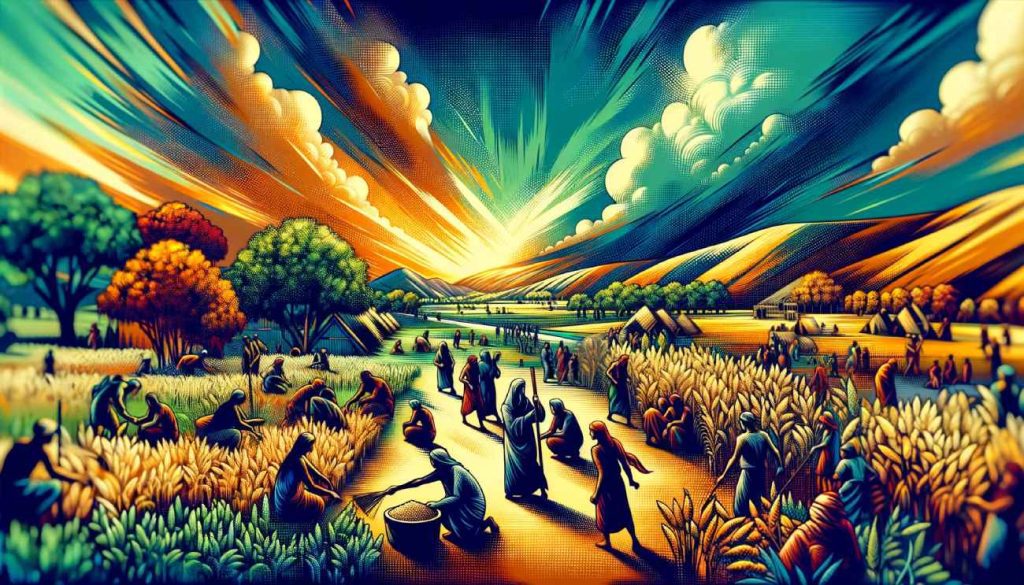
These conditions incentivized bands in the Fertile Crescent to go from casually scattering seeds to deliberately cultivating favored grains and legumes.
These conditions incentivized bands in the Fertile Crescent to go from casually scattering seeds to deliberately cultivating favored grains and legumes.
Early Farming Practices
Archaeology and ancient tools provide clues about early cultivation methods:
-
Hoes fashioned from stone, bone and wood were used to break up soil and create planting mounds for seeds.
-
Digging sticks leveraged to punch holes for planting seeds like squash and tubers.
-
Seeds of wild progenitors were selectively planted to favor beneficial traits like bigger grains and higher yields.
-
Irrigation was employed in drier areas like Egypt along the Nile where annual floods renewed fertilizing soil deposits.
-
Livestock including goats, sheep and pigs were corralled and bred, providing manure to enhance soil fertility for crops.
These nascent farming techniques gradually replaced wide-ranging hunting and gathering lifestyles in certain regions with the new found ability to produce bountiful food stores close to home.
Spread of Early Agriculture
-
Levant– Wheat, barley, peas, lentils and goats were first domesticated starting around 9500 BCE. Permanent settlements like Jericho arose.
-
Andes– Squash, potatoes and quinoa were early crops. Llamas and alpacas were domesticated by 3500 BCE. Terracing multiplied small plots for farming.
-
Mesoamerica– Corn, beans, squash and turkeys were farmed by 6000 BCE. Chinampas allowed crops to be grown in shallow swamps.
-
Sub-Saharan Africa– Agriculture developed independently by 3000 BCE with crops like sorghum and yams. Iron tools helped clear land for farming.
-
Asia– Rice and millet were grown in China by 7500 BCE. Bananas, yams and taro cultivated in Papua New Guinea.
-
Europe– Wheat and livestock came via the Near East around 5500 BCE, along with plows. Oats, rye and legumes followed.
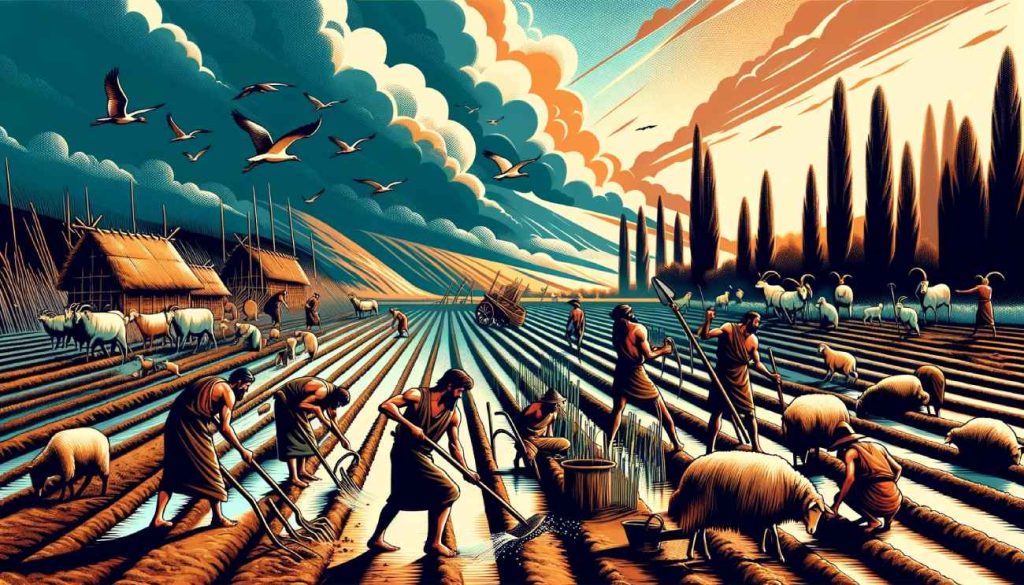
This global diffusion transformed hunter-gatherer lifestyles nearly everywhere into settled agricultural communities growing specialized, locally adapted crops and raising domesticated animals by 3000 BCE.
This global diffusion transformed hunter-gatherer lifestyles nearly everywhere into settled agricultural communities growing specialized, locally adapted crops and raising domesticated animals by 3000 BCE.
Agriculture in Ancient Civilizations
The food surpluses yielded by early agriculture allowed cities, specialized trades and complex cultures to emerge across the globe. Farming progressed in tools and techniques during this era.
Ancient Mesopotamia
This region between the Tigris and Euphrates Rivers nurtured agriculture thanks to abundant water and silt left by seasonal floods. Farmers grew a diverse array of crops:
-
Grains – emmer wheat, barley, einkorn wheat
-
Legumes – lentils, chickpeas, beans, peas
-
Fruits – dates, grapes, olives, figs, pomegranates
-
Vegetables – leeks, garlic, onions, turnips, cucumbers
Livestock included sheep, cattle and goats. Mules and oxen pulled plows. Key farming tools and techniques included:
-
Bronze sickles for harvesting grains
-
Irrigation canals delivering river water to fields
-
Manuring to boost soil fertility
-
Fallowing leaving fields unplanted temporarily to restore nutrients
Their food surplus birthed the world’s first cities like Uruk by 4000 BCE and complex writing to track crop storage and transfers. Land ownership and taxation of farms developed in the bureaucratic societies of Mesopotamia.
Ancient Egypt
Egyptian agriculture relied on the Nile’s seasonal flooding, which deposited nutrient rich silt ideal for growing crops.
-
Wheat, barley and flax were grown for bread, beer and linen
-
Papyrus reeds proliferated in marshlands, providing writing material
-
Grapes, figs and dates were grown, along with cabbage, onions and cucumbers
In basins along the Nile, farmers practiced flood recession agriculture:
-
As floodwater receded, seeds were sown directly in the moist soil
-
Oxen or donkeys pulled wooden plows to work the land
-
Grain was harvested with curved sickles, then threshed to separate from stalks
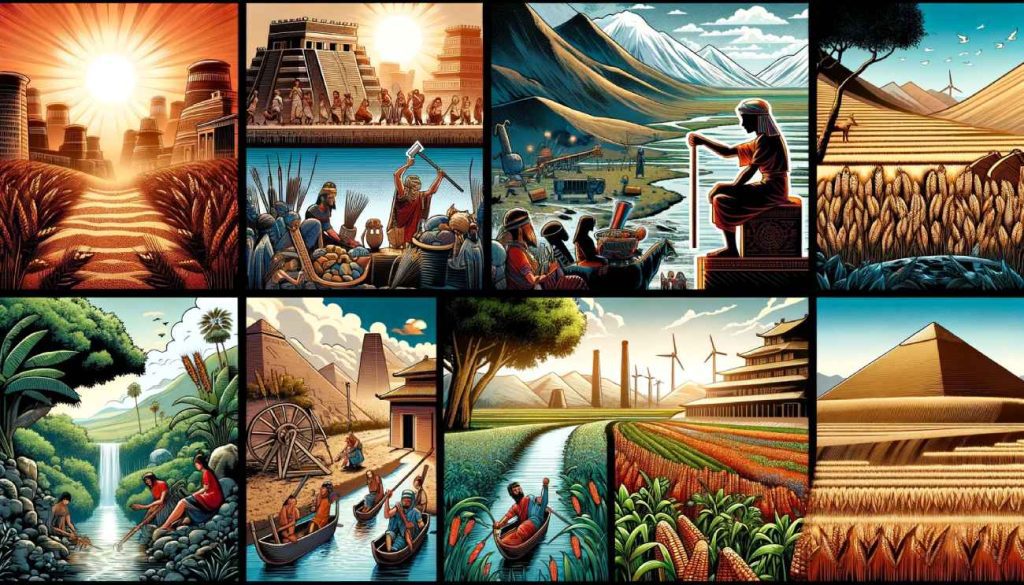
Egyptian farmers paid taxes in shares of grain harvested. The construction of irrigation canals and dams helped control flooding and extend farmland along the Nile.
Egyptian farmers paid taxes in shares of grain harvested. The construction of irrigation canals and dams helped control flooding and extend farmland along the Nile.
Ancient India
India’s climate supported the cultivation of staple crops relied upon to this day:
-
Rice in the rainy south
-
Wheat and barley in the drier north
-
Cotton, sesame seeds and sugarcane
-
Lentils, grams and peas for protein
Key aspects of ancient Indian agriculture included:
-
Ox-drawn plows equipped with iron tips to break up thick soils
-
Terraced farming in hilly regions to create arable land
-
Irrigation with reservoirs and lined canals
-
Crop rotation between nitrogen fixing legumes and cereals
The seasonal monsoon rains made flood control critical. Temple dams helped manage water for irrigation. Records suggest soybeans, oranges and peaches came from China by 100 BCE along the Silk Road.
Ancient China
China’s two major river systems – the Yellow River in the north and the Yangtze in the south – served as cradles for ancient Chinese agriculture:
-
Northern crops – millet, wheat, barley, soybeans
-
Southern crops – rice, tea, mulberry
-
Widespread crops – cabbage, melons, onions, peas
Key innovations included:
-
Oxen pulling iron plows equipped with two blades to cut through thick soils
-
Row cultivation with specialized tools for crops like wheat, rice, soybeans and sugarcane
-
Seed drills that enabled efficient, even sowing of seeds
China also practiced aquaculture and silkworm cultivation on a large scale. Agricultural techniques were continually refined according to detailed records kept by scholars and officials.
Ancient Americas
Indigenous societies across North and South America domesticated regionally important crops:
-
Mesoamerica– Corn, beans, squash, tomatoes, sweet potatoes, avocados, chocolate
-
Andes– Potatoes, quinoa, peppers, peanuts, cotton
-
North America– Sunflowers, blueberries, cranberries, pecans
Key innovations included:
-
Chinampas – Artificial agricultural islands built in shallow lakes in central Mexico
-
Terracing – Mountain terraces built by the Inca to expand arable land
-
Fertilizer – Guano deposits were mined and spread over fields
-
Alpacas and llamas provided transport and fiber
Maize became a staple crop across much of the Americas. Irrigation, chinampas and terraces enabled agriculture in challenging terrains.
Medieval Agriculture
Agriculture in Europe regressed with the fall of the Roman Empire, but began improving by the 10th century with new tools and techniques.
Self-Sufficient Manors
During much of the Middle Ages, rural life and agriculture centered around manors. Lords owned large manors, but divided land into:
-
The lord’s enclosed domain which was farmed for his benefit
-
Peasant’s strips on which they raised crops for their families
This system provided stability by tying serfs and peasants to the land. Technology like water-powered mills helped grind grain. But productivity remained low.
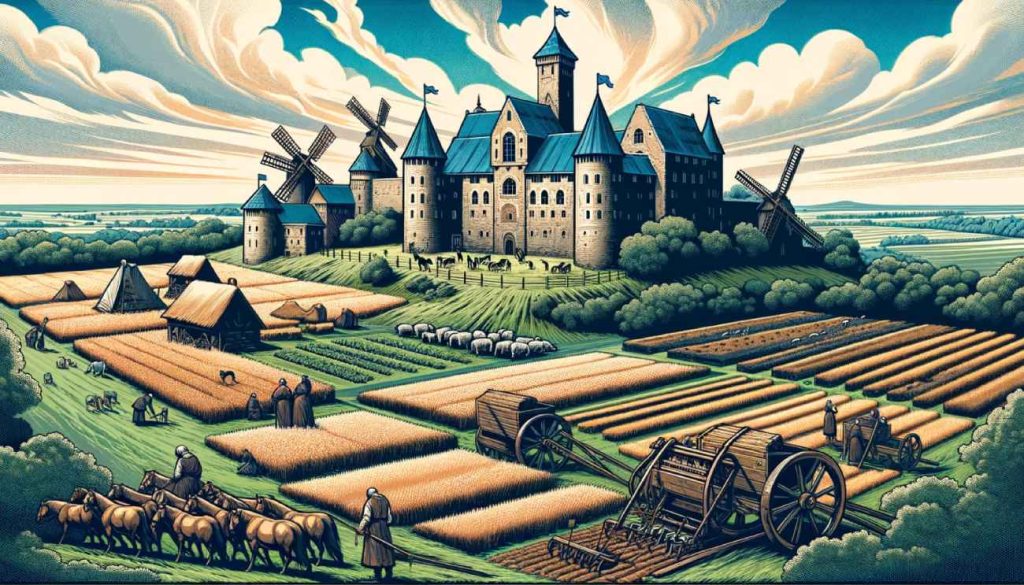

The Open Field System
In the late Middle Ages, agriculture moved toward open field systems in many areas:
-
Peasant families were allocated larger strips spread among two to three large communal fields.
-
The fields were farmed in rotation, with one left fallow each year to replenish nitrogen.
-
Livestock grazed on fallow fields and stubble after harvest. Their manure fertilized soils.
This system increased efficiency by better distributing farmland and resources. Agricultural tools improved as well.
Improved Farm Tools
Several innovations propelled medieval agriculture after 1000 CE:
-
Heavy wheeled plows with an asymmetric moldboard to turn over thick or gravely soils
-
Horse collars allowing horses to pull plows and equipment rather than slower oxen
-
Three-field crop rotation to alternate wheat or rye, lower value grains, and fallow fields
-
Watermills and windmills reducing labor to process crops like grains
These advances laid the foundation for increased food production and population growth.
Agriculture in Early Modern Times 1500-1700
The Colonial Era saw dramatic expansions in the variety of crops as explorers encountered new plants and transferred species between continents.
Crops Spreading From the Columbian Exchange
Explorers returning from the Americas reintroduced several nutritious crops to the rest of the world:
-
Corn, potatoes, and tomatoes from the Americas to Europe
-
Wheat, sugarcane, and coffee from the Old World to the Americas
-
Peanuts, pineapple, and tobacco traveled from South America to Asia and back
-
Grapes, citrus fruits, and almonds expanded to new geographies
This transfer of plants and farming knowledge between civilizations transformed diets and agricultural practices across the globe.
Cash Crop Plantations
European colonialism led to large plantations growing crops like sugar, cotton, tobacco, and indigo for export back to Europe:
-
Caribbean – Sugarcane and tobacco grown using slave labor
-
American South – Cotton and tobacco grown on vast plantations
-
Brazil – Sugarcane grown for export to make sugar and rum
-
Asia – Spices like pepper, clove, nutmeg and tea established
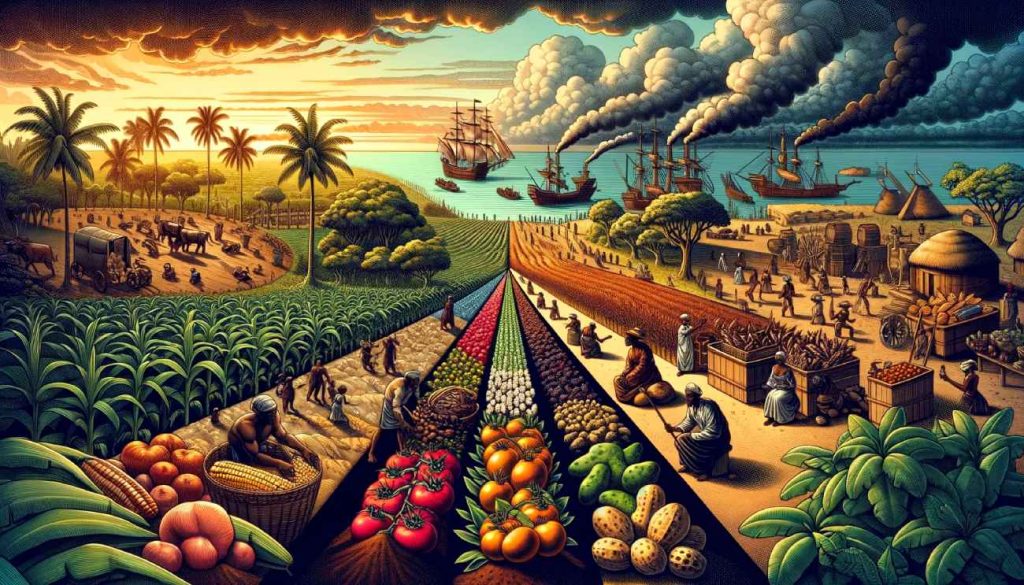
These cash crops offered high profit but caused major social impacts through slavery, inequality and colonialism. Plantation systems strained soils with repetitive crops.
These cash crops offered high profit but caused major social impacts through slavery, inequality and colonialism. Plantation systems strained soils with repetitive crops.
Cottage Industry Farming
In contrast to large plantations, cottage industry farming emerged in which peasant farmers used their own small plots to grow crops like flax, wool, and silk:
-
Families produced materials needed for clothing and items in demand by society
-
Goods were often bought by traveling merchants and resold in cities
-
Limited outside labor was needed, with families providing most of the intensive work
This supplementary income could support peasants between growing seasons. Women often managed poultry, gardens and silkworms to generate additional income in this system.
Agriculture in the Industrial Era
The Industrial Revolution drove widespread changes in agricultural technology, crop choices and farm structure that allowed far greater food production.
The Agricultural Revolution
In Britain, farming underwent an Agricultural Revolution between 1700 and 1900:
-
Enclosure consolidated small peasant plots into larger commercial farms owned by wealthy landowners
-
Jethro Tull invented the seed drill in 1701 allowing efficient sowing of seeds in straight rows
-
Selective breeding improved yields of crops and livestock like cows and sheep
-
The Norfolk four-course crop rotation system maintained soil fertility by alternating different crops
These enhancements increased productivity, but pushed poor tenant farmers and laborers off the land into cities.
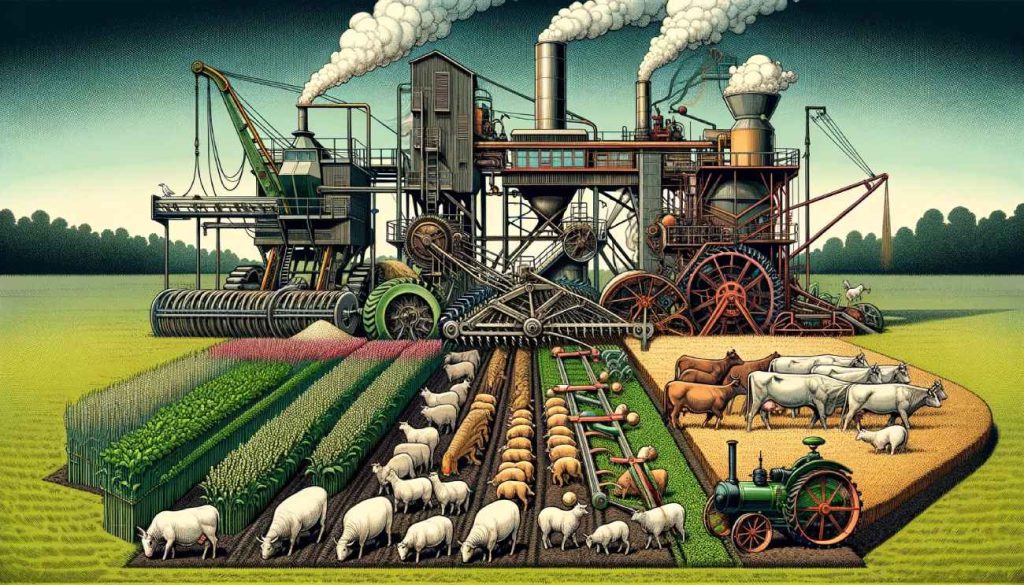

Mechanization Arrives
New machines appeared that reduced the labor needed in farming:
-
Mechanical seed drills that applied seeds more uniformly using less labor
-
Horse-drawn reapers and binders to harvest grains like wheat and hay
-
Threshing machines to rapidly separate grains from stalks
-
Steam tractors that began pulling heavier implements in the mid-1800s
Cyrus McCormick patented the mechanical reaper in 1834, later forming International Harvester which drove widespread tractor adoption after 1910.
Government Promotion of Agriculture
Industrialized countries invested heavily in agricultural science and education:
-
Land-grant colleges like the University of California, Michigan State, and Texas A&M focused on practical agriculture, engineering and military training
-
Government agencies offered scientific expertise on topics like soil management, irrigation, and livestock breeding
-
Subsidies, loans and grants provided funds to help farmers mechanize and adopt new methods
-
Infrastructure like rural electrification brought power for equipment and transport links through rails and roads
These efforts boosted yields through technology and scientific crop cultivation.
Table 1. Innovations Propelling the Agricultural Revolution
CategoryInnovationsEquipmentMechanical reaper, steel plow, combined harvesterPowerSteam tractors and threshersCropsTurnips, clover, and grasses for fodder crop rotationLivestockSelective breeding for larger cows, sheep, and chickensFarm StructureConsolidation into larger enclosed farms owned by landlords
Modern Agriculture in the 20th Century
Technologies like mechanization along with scientific plant and animal breeding drove major gains in agricultural productivity during the 20th century.
The Green Revolution
This paradigm began in the 1940s as a concentrated effort to increase yields to address hunger in developing countries:
-
High-yielding varieties– Crops like wheat, rice and maize were selectively bred to favor higher grain production.
-
Fertilizers– Synthetic nitrogen fertilizers were affordably mass produced using the Haber-Bosch process to stimulate plant growth.
-
Irrigation– Dams, canals and tube wells provided water access to increase cropland.
-
Pesticides– Insecticides reduced crop losses to pests, but caused environmental issues.
-
Machinery– Widespread tractor use and combine harvesters replaced animal power and human labor.
This package of technologies had dramatic results in Asia and Latin America, averting famine and increasing food production. Critics point to heavy environmental impacts and loss of crop diversity.
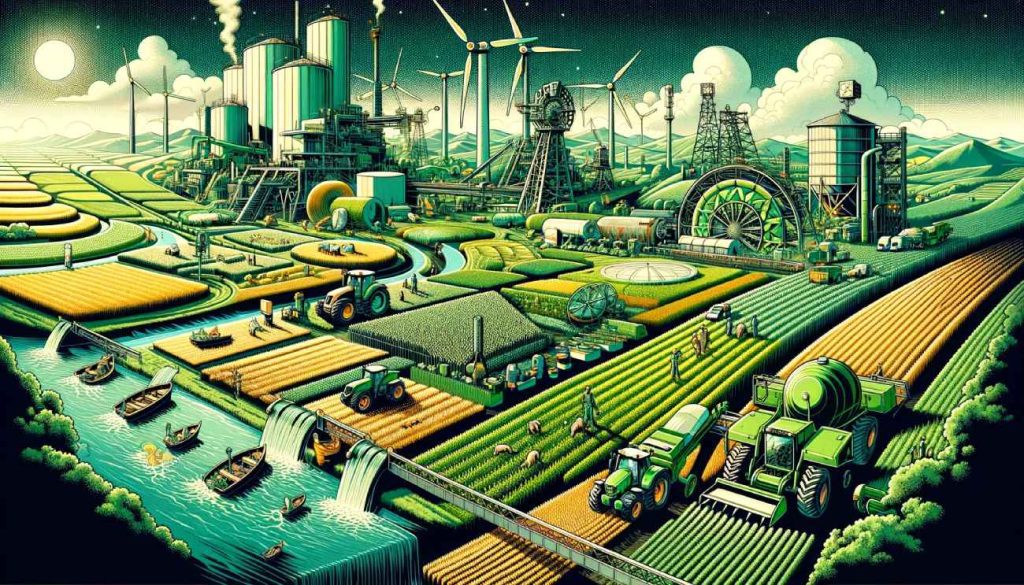

Factory Livestock Production
Driven by demand for cheap meat, concentrated animal feeding operations (CAFOs) emerged starting in the 1950s:
-
Animals are densely confined in indoor facilities opting for larger scale production over pasture access
-
Feed is delivered to animals instead of allowing them to graze
-
Breeding focuses on faster growth over animal health
-
Waste lagoons concentrate untreated animal waste
This industrial approach supplies most meat but raises concerns about ethics, health, overuse of antibiotics and pollution.
Advancements in Plant Breeding
Science has continued improving crop genetics, shifting from simply selecting desirable plants to direct manipulation at the molecular level:
-
Hybrid breedingcreates high performing offspring by crossing different parent varieties
-
Mutation breedinginduces random mutations to create new traits using radiation or chemicals
-
Genetic engineeringdirectly inserts specific genes to bestow targeted attributes like pest resistance
These methods provide access to crop traits that may not exist naturally. Supporters tout higher yields, but critics argue for caution with long-term impacts on health and ecosystems.
Table 2. Hallmarks of Modern Agriculture
TechnologyDescriptionMechanizationTractors, combines, milking machinesSynthetic fertilizers and pesticidesAffordable nitrogen fertilizers and insecticidesHybrid seedsCrossbreeding distinct parent varietiesIrrigationLarge dams and tube wells extend farmlandCAFOsConcentrated feedlots and confinement of livestock
Emerging Agriculture Technologies
Powerful new technologies continue to emerge that bring both promises and risks for the future of farming.
Precision Agriculture
Precision agriculture uses data gathering sensors, drones and satellite imagery to optimize inputs on farms:
-
GPS equipment steers automated tractors and machinery without drivers
-
Soil moisture sensors and aerial imaging show what crops need more nutrients or water
-
Robotic thinners precisely remove excess plants early on
-
Variable rate technology customizes applications of fertilizer, water, or pesticides variably across a field based on need
Proponents believe these techniques provide more food with fewer wasted resources. Critics argue it reinforces reliance on chemicals and marginalizes labor.
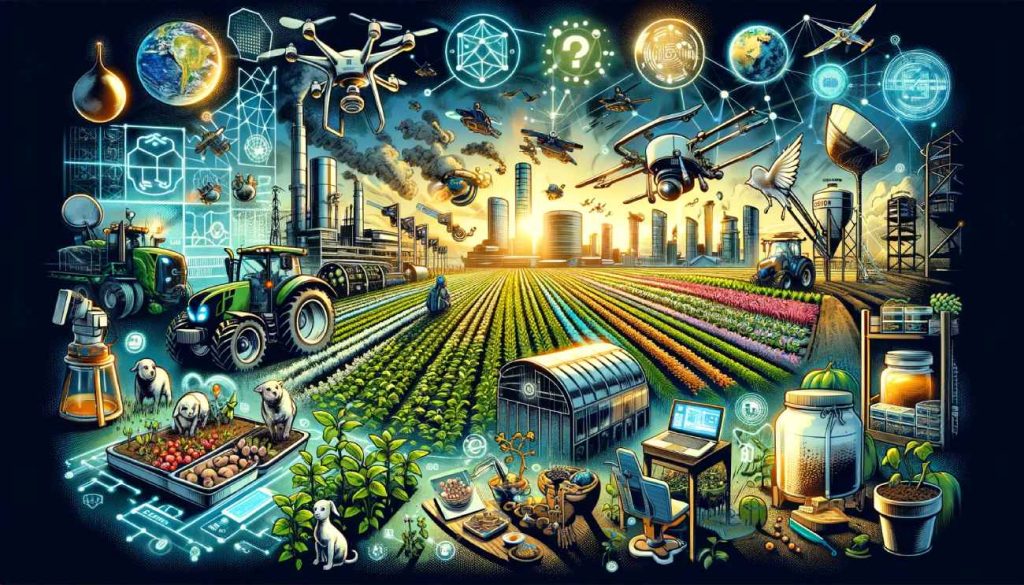

Controlled Environment Agriculture
Indoor vertical farming and greenhouses enable greater control over growing conditions:
-
Hydroponics provide nutrients directly to plant roots without soil
-
LED lights can be adjusted to favor growth without the need for sunlight access
-
A controlled environment allows year-round production independent of climate
-
Automated stacking and handling systems enable very high-density vertical farms
Supporters see benefits for urban locales and resilience against climate change. Others question the high energy demands.
Cellular Agriculture
Cellular agriculture aims to produce agricultural products like meat and milk from cell cultures instead of raising animals:
-
Cell samples are taken from livestock
-
The cells are cultured and nourished to grow in bioreactors
-
The process replicates meat and milk products without slaughter or farming
Proponents view it as more ethical and sustainable. Critics counter that the technology remains speculative and energy intensive.
Gene Editing
New gene editing methods like CRISPR offer ways to alter plant and animal genetics with increased precision:
-
Specific genes can be silenced or inserted without introducing outside DNA
-
Plant natural immunity could be boosted to resist disease
-
Gene edits might remove allergens or toxins in crops
This expanding technology holds promise but requires careful oversight regarding permanent changes to genomes and ecosystems.
Blockchain Technology
Blockchain offers a way to track authenticity and origins of agricultural products:
-
Data is entered at each step of production, processing, and distribution
-
Records are distributed on shared ledger databases that are extremely hard to falsify
-
Consumers can scan items to verify provenance claims about organic, fair trade, non-GMO, etc.
Supporters see blockchains bringing radical transparency. Issues like data privacy and excluding smallholders need addressing.
Robotic Farm Workers
Robots are taking on more duties on farms traditionally requiring human labor:
-
Robotic pickers with vision systems identify and selectively harvest ripe produce
-
Driverless tractors can precisely plant seeds, spread fertilizer, and weed crops
-
Robotic arms mimic dexterous human movements for handling delicate food items
Proponents envision expanding automation to alleviate farm labor shortages. Critics argue it reinforces consolidation into factory-scale operations.
Remote Sensing
Public and commercial satellites monitor environmental conditions and crop development:
-
Sensors assess moisture levels, plant cover, and growth changes over time
-
Images help pinpoint irrigation needs or pest infestations
-
Data layers can map soil types, topography, and other meaningful patterns
Remote sensing supports wider adoption of precision agriculture. Privacy issues and costs need addressing.
Artificial Intelligence
AI systems are helping farmers respond to variability and unpredictability:
-
Machine learning algorithms are trained on farm data to detect crop stress and predict outcomes
-
Computer vision identifies weeds, pests, and diseased plants needing removal
-
Chatbots provide customized recommendations for inputs and practices
-
Voice command interfaces allow hands-free operation of machinery and monitoring
AI holds promise to support data-driven decisions on farms. But bias in data and algorithms needs to be addressed.
Looking to the Future
With the global population estimated to reach 10 billion by 2050, agriculture faces immense challenges to provide enough affordable, nutritious food sustainably:
-
Climate change: threatens to disrupt production with higher temperatures, severe weather events and shifting rainfall patterns
-
Environmental impacts: like soil erosion, sinking aquifers, and fertilizer runoff degrade critical resources
-
Changing diets: mean more demand for resource-intensive foods like meat and dairy products
-
Biofuels: present tradeoffs between crops for food versus fuel
-
Land conversions: deforestation erode biodiversity and natural carbon sinks
-
Food waste: squanders resources invested across the supply chain
Addressing these complex, interrelated challenges will require holistic efforts across sectors, communities and nations. Smarter policies, science-based best practices, and emerging technologies each have roles to play in transitioning agriculture to be regenerative, climate-friendly and nourishing for all.
The long history of agricultural advancement shows that humanity has the capacity to meet the future through ingenuity and global cooperation. But it will take the work of many hands and minds across diverse disciplines to craft solutions tailored to an interconnected world facing 10 billion mouths to feed sustainably.
For 10,000 years and counting, agriculture has enabled our species to expand and societies to flourish. Over that vast sweep of history, human ingenuity domesticated plants and animals, developed specialized tools, and engineered higher-yielding breeds and cropping systems.
Agricultural technology has always aimed to grow more food with fewer resources and labor. Today’s innovations carry on that progress but also raise new questions. Will small farms continue to proliferate or consolidate into larger industrial operations? Can humanity achieve sustainable, climate-friendly agriculture that nourishes everyone on the planet? The future remains unwritten.
As the global population heads towards 10 billion, this long history of agricultural advancement gives hope that farmers can adapt and rise to meet the challenges ahead. Past agricultural revolutions have proven that human invention paired with responsible policies can craft solutions to feed more people while stewarding our natural resources for the long haul. The next agricultural revolution starts now.
